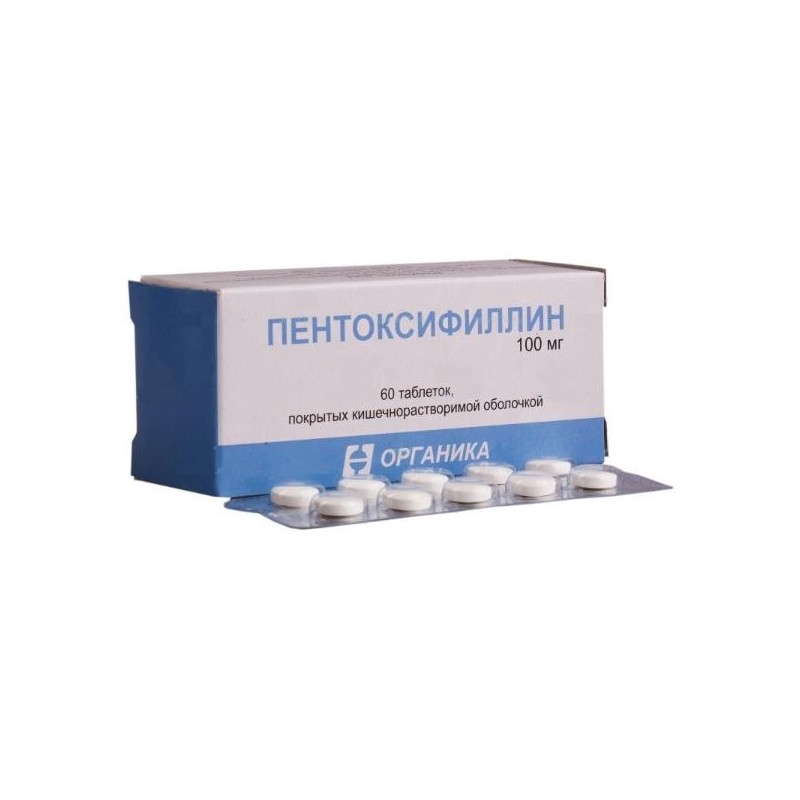



Pentoxifylline is a derivative of xanthine. Improves microcirculation and rheological properties of blood. The mechanism of action is associated with inhibition of phosphodiesterase and an increase in the content of cyclic 3.5 adenosine monophosphate (3,5-AMP) in platelets and adenosine triphosphate (ATP) in erythrocytes with simultaneous saturation of the energy potential, which in turn leads to vasodilatation, decrease in total peripheral vascular resistance, an increase in systolic and minute blood volume without a significant change in heart rate. Expanding the coronary arteries, increases the delivery of oxygen to the myocardium (a slight antianginal effect), the vessels of the lungs - improves blood oxygenation.
When administered intravenously leads to increased collateral circulation, an increase in the volume of blood flowing through the unit section.
Reduces blood viscosity, causes disaggregation of platelets, increases the elasticity of red blood cells (due to the impact on the pathologically changed deformability of red blood cells). Improves microcirculation in the areas of impaired blood circulation.
When occlusive lesion of peripheral arteries ("intermittent" lameness), leads to a lengthening of the walking distance, the elimination of night cramps of the calf muscles and pain at rest.
Pharmacokinetics
The drug after administration is rapidly metabolized in the liver. In the process of metabolism, the formation of two major metabolites: 1- (5-hydroxyhexyl) -3,7-dimethylxanthine (metabolite I) and 1- (3-carboxypropyl) -3,7-dimethylxanthine (metabolite V), which have a similar activity to pentoxifylline . 1.5-2 hours after the infusion, the concentration of metabolites I and V in plasma is 5 and 8 times higher, respectively, than the concentration of the initial substance. By the 8th hour, the concentration of pentoxifylline and its metabolites in the blood is significantly reduced (up to 10% of the initial).
The half-life is from 30 minutes to 1.5 hours. Excreted predominantly by the kidneys (94%) in the form of metabolites (mainly metabolite V), the intestine (4%). up to 90% of the dose is eliminated in the first 4 hours. 2% of the drug is excreted unchanged. Pentoxifylline and its metabolites do not bind to plasma proteins.
It is excreted in breast milk.
In severe renal impairment, excretion of metabolites is delayed. With abnormal liver function, there is a prolongation of the half-life and an increase in bioavailability.
1 tablet contains:
Active substance: pentoxifylline (in terms of 100% substance) - 100 mg;
Excipients: stearic acid, potato starch, water-soluble methylcellulose, lactose (milk sugar), povidone (low molecular weight medical polyvinylpyrrolidone)
Shell composition: cellulose (acetylcellulose), titanium dioxide, castor oil, liquid paraffin (vaseline oil), azorubine (acid red 2 C), talc, beeswax
Pentoxifylline is marketed under different brands and generic names, and comes in different dosage forms:
| Brand name | Manufacturer | Country | Dosage form |
|---|---|---|---|
| Pentoxifylline | Organica | Russia | pills |
| pills | |||
| Pentoxifylline-SOLOpharm | solution | ||
| Trental | Sanofi-aventis | France | ampoules |
| Trental | Sanofi-aventis | India | pills |
| Pentoxifylline | Zentiva KS | Czech | pills |
| Pentoxifylline | Pharmproject | Russia | pills |
| Pentoxifylline | Biochemist Saransk | Russia | ampoules |
| Vasonit | G.L.Farma GmbH | Austria | pills |
No customer reviews for the moment.
For oral use. after eating. pills are coated with a special coating that is soluble in the intestines, so they are swallowed whole, washed down with a small amount of water. Take 0.2 g (2 pills) 3 times a day. After reaching a therapeutic effect (usually 1-2 weeks), the dose is reduced to 0.1 g (1 tablet) 3 times a day.
The maximum daily dose is 1200 mg. The course of treatment is 1-3 months.
In patients with chronic renal failure (creatine clearance less than 10 ml / min.), The dose is halved.
The duration of treatment and the dosage regimen of Pentoxifylline is determined by the attending physician individually, depending on the clinical picture of the disease and the resulting therapeutic effect.
From the digestive system: dry mouth, decreased appetite, intestinal atony, exacerbation of cholecystitis, cholestatic hepatitis.
From the senses: blurred vision, scotoma.
Since the cardiovascular system: tachycardia, arrhythmia, cardialgia, progression of angina pectoris, lowering blood pressure.
From the side of blood-forming organs and hemostasis system:thrombocytopenia, leukopenia, pancytopenia, hypofibrinogenemia; bleeding from the vessels of the skin, mucous membranes. stomach, intestines.
Allergic reactions: itching, skin flushing, urticaria, angioedema, anaphylactic shock.
Laboratory indicators: increased activity of liver transaminases (ALT, ACT, LDH) and alkaline phosphatase.
Carefully:the drug is prescribed to patients with atherosclerosis of cerebral and / or coronary vessels, especially in cases of arterial hypotension and cardiac arrhythmias, heart failure, liver failure. Caution should also be exercised when prescribing pentoxifylline in patients with gastric ulcer and duodenal ulcer in patients who have recently undergone surgery (risk of bleeding).
Pentoxifylline enhances the action of heparin, fibrinolytic drugs, theophylline, antihypertensives and hypoglycemic agents (both insulin and oral hypoglycemic agents).
Pentoxifylline can enhance the action of drugs that affect the blood coagulation system (indirect and direct anticoagulants, thrombolytics), antibiotics (including cephalosporins - cefamandol, cefoperazone, cefotetan), valproic acid.
Cimetidine increases the concentration of pentoxifylline in the blood plasma (the risk of side effects).
Joint appointment with other xanthines can lead to excessive nervous excitement of patients.
Pentoxifylline is contraindicated during pregnancy and is not recommended for use during breastfeeding.
Symptoms: nausea, dizziness, cyanosis, tachycardia, marked reduction in blood pressure, redness of the skin, fever (chills), agitation, areflexia, tonic-clonic convulsions, vomiting “coffee grounds”, arrhythmia, loss of consciousness.
Treatment: symptomatic. Particular attention should be paid to maintaining blood pressure and respiratory function. Convulsions are relieved by the administration of diazepam. Urgent measures in case of severe anaphylactic reactions (shock):
Studies and clinical trials of Pentoxifylline (Click to expand)